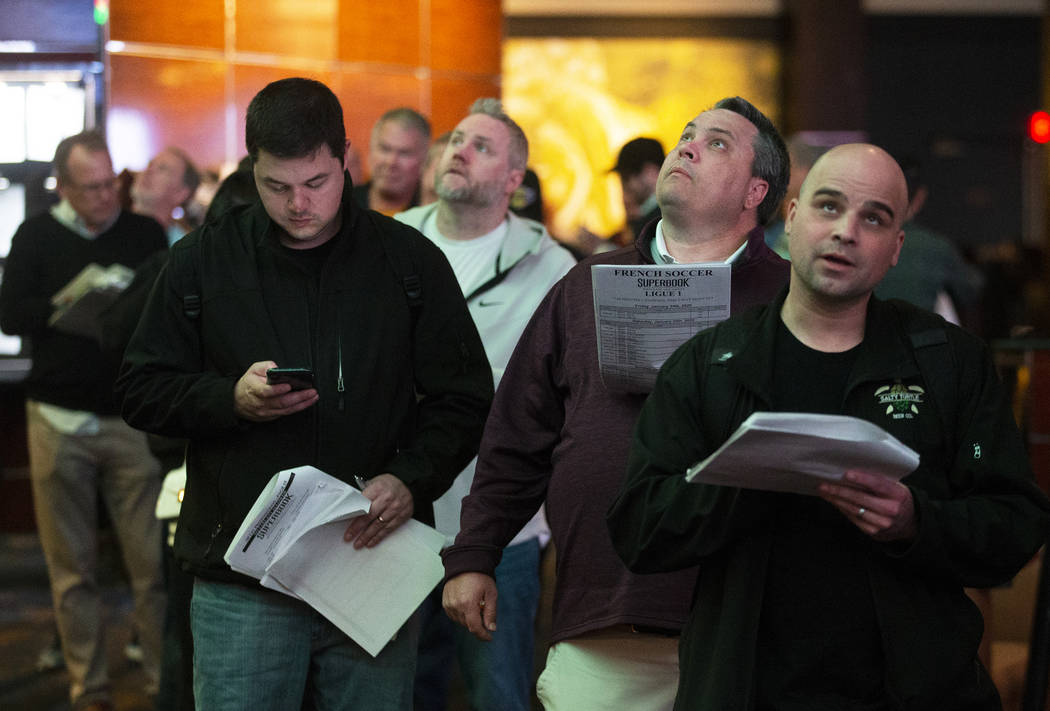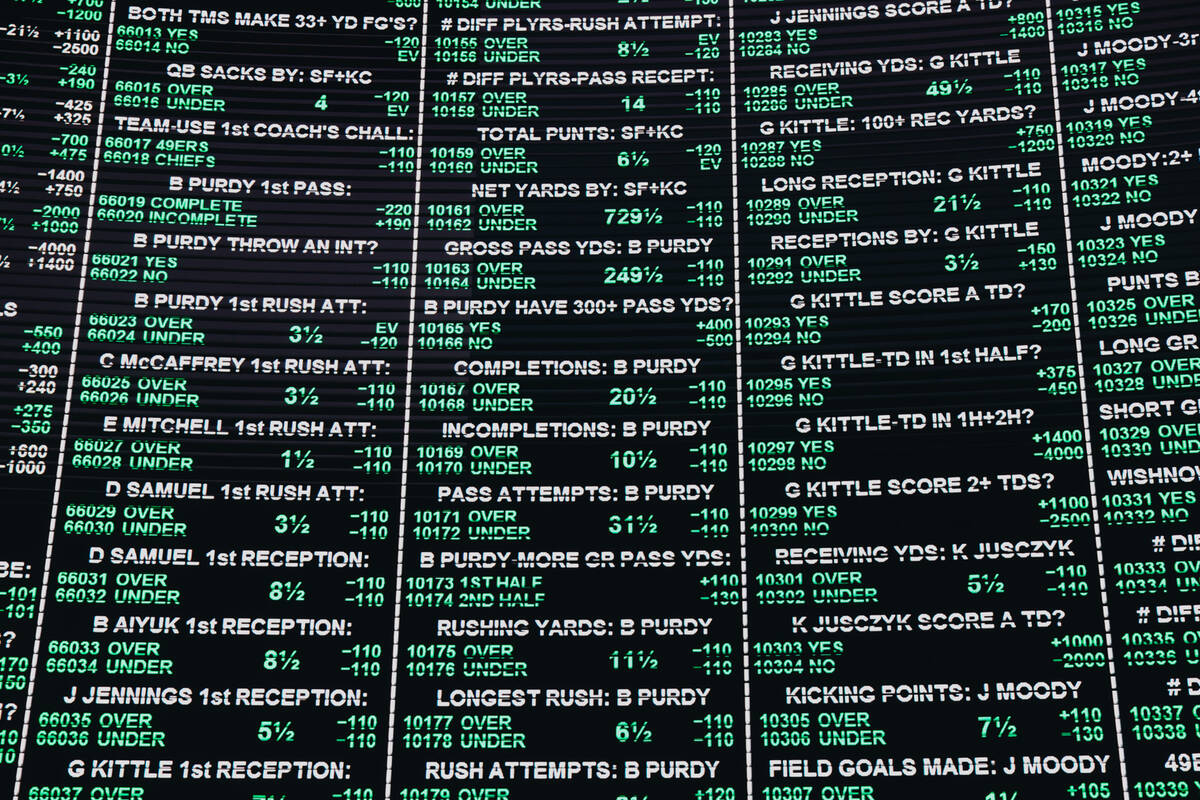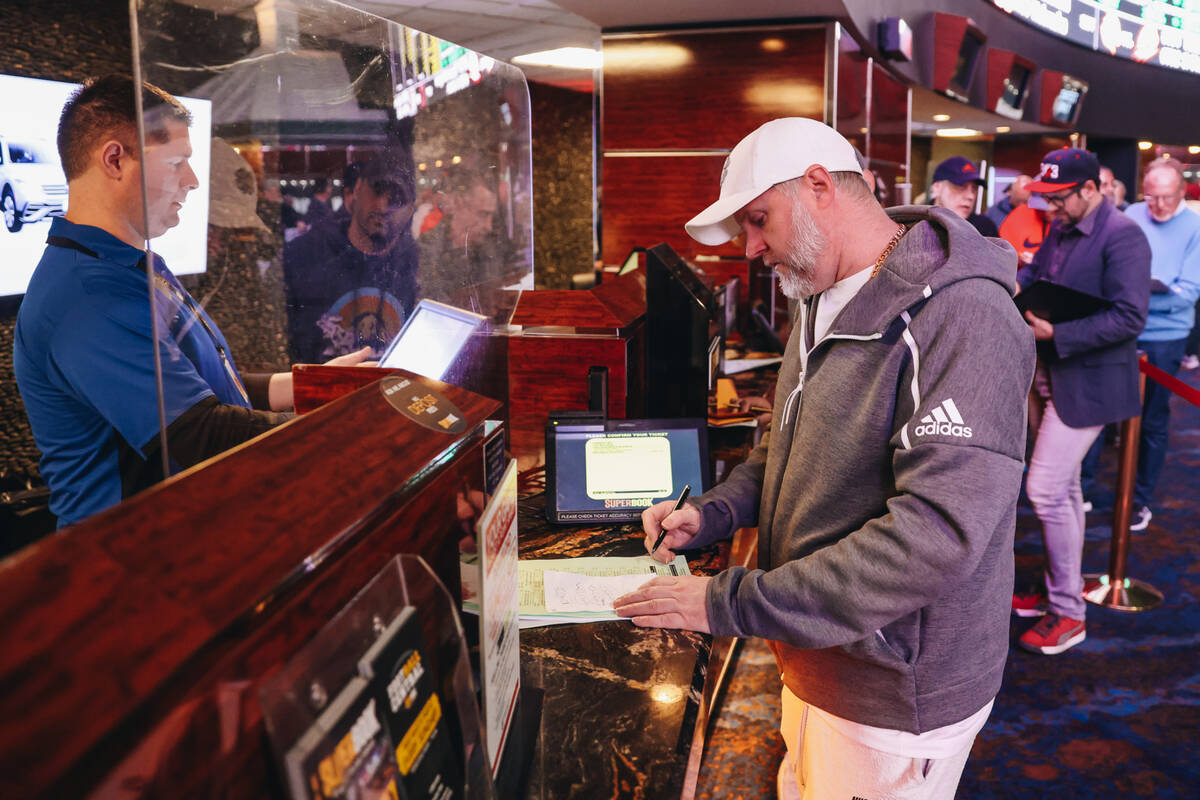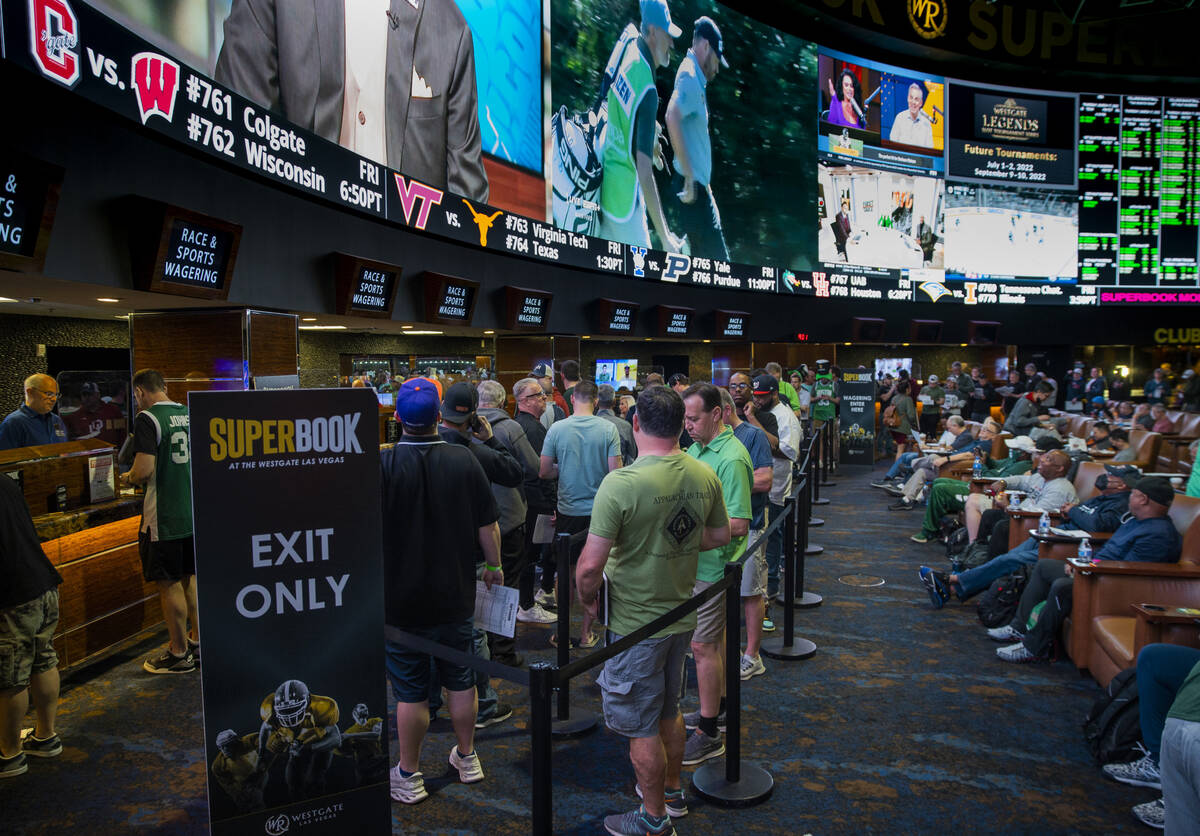Betting 101: A primer for betting in a sportsbook
A sportsbook can be an intimidating place for the uninitiated.
Here’s a primer on the basics of betting. Though most of these rules are standardized, individual casino rules may vary.
Glossary
— Favorite: The team projected to win a game. (A team also can be favored to win a playoff series or overall league championship.)
— Juice: The terms of a bet. Synonymous with “vig” and “vigorish.”
— Money line: The odds on a team to win a game, regardless of the spread. Favorites are expressed with a minus sign (example: -150, meaning a bettor can bet $150 to win $100). Underdogs are expressed with a plus sign (example: +130, meaning a bettor can bet $100 to win $130).
— Over/under: See total.
— Point spread: A number used to even the betting odds between two teams, usually football and basketball. If the point spread is 7, the favorite must win by more than 7 points to win “against the spread.” Underdogs must win the game or lose by fewer than 7 points. If the favorite wins by exactly 7 points, the bet is a push, and all bettors get their money back.
— Push: A tie. If a game or total lands on the exact point spread or total, the game is a push, and all bets are refunded.
— Rotation number: The number assigned to a game and/or team for betting purposes. It will be listed next to the team name on the betting board. Bettors use this number instead of the team names when placing a bet. (Example: “Give me $100 on 372,” not “give me $100 on North Carolina.”)
— Side: A team in an against the spread bet. (Do you like a side in that game?)
— Terms: The odds a bet is placed at. See juice. Commonly -110 for against the spread bets (bet $110 to win $100).
— Total: The projected combined score of both teams for a game. Synonymous with “over/under.”
— Underdog: The team projected to lose a game or playoff series.
Types of bets
Against the spread
The most common way to bet football and basketball, the point spread serves to even the playing field for the two teams. The favorite must win by more than the point spread to win the bet; underdogs must win the game or lose by less than the point spread to win the bet. (Example: Alabama is a 7-point favorite over Auburn. The final score is Alabama 27, Auburn 24. Auburn +7 bettors win; Alabama -7 bettors lose.)
If the favorite wins by exactly the point spread, the game is a push, and bettors get their money back.
The odds, or terms, of an against the spread bet are usually -110 (11-to-10 odds), meaning a bettor must bet $110 to win $100, $50 to win $45.45 or $22 to win $20, etc. Occasionally, the terms will be different, usually -120 on one side (bet $120 to win $100) and +100 or EVEN on the other side (bet $100 to win $100). Sportsbooks do this when they don’t want to move the point spread of a game but still want to attract bettors to one side. If the terms are different from -110, they will be expressed alongside the team name on the betting board.
When placing the bet, use the rotation numbers next to the team name instead of the team name.
Right: “Give me $100 on 372.” Wrong: “Give me $100 on Alabama.”
Totals
Also commonly called the “over/under,” bettors wager on whether the combined points in a game from both teams will go over or under the projected total. (Example: The total on Alabama vs. Auburn is 50 points. If the final score is Alabama 27, Auburn 24, then the game is “over.”)
If the teams’ combined score is the same as the total, the game is a push, and bettors get their money back.
Like against the spread bets, the terms of the bet are usually -110, but can be shifted, usually to -120 on one side and +100 or EVEN on the other side.
One wrinkle: Totals do not have their own rotation number. Use the rotation number for one of the teams involved in the game, plus “over” or “under.”
Right: “Give me $100 on 372 under.” Wrong: “Give me $100 on 372.” (This will be an against the spread bet on the team assigned to 372.)
Money line
A simple bet on which team will win the game. No point spread involved.
The terms are listed beside each team after the spread and total. Favorites are expressed with a minus sign (-180), and underdogs are expressed with a plus sign (+160). In this example, bettors would have to bet $180 to win $100 on the favorite or bet $100 to win $160 on the underdog.
As with totals, there is no specific rotation number for money-line bets. Use the rotation number of the desired team, plus “money line.”
Right: “Give me $100 on 372 money line.” Wrong: “Give me $100 on 372.” (This will be an against the spread bet on the team assigned to 372.)
Halftime bets and first-half bets (and other variations)
Bets on the outcome of one half of the game.
Before the game, bets can be placed on the first half of football and basketball games, the first five innings of a baseball game or the first period of a hockey game.
For football and basketball, bets can be placed at halftime, at a line set for just the second half of play. The overall result of the game does not matter, just the result against the second-half spread or total.
These bets have their own rotation numbers. A common mistake is for a bettor to use the full-game rotation number when trying to place a first-half bet.
Futures
Bets on events that will be decided in the future, usually seasonlong bets on a team to win a championship. Bets also can be made on a team to win a division or conference, and sometimes bets are allowed on individual seasonlong awards, such as the Heisman Trophy or league MVP.
The odds are not static. They change week by week or even day by day as the season progresses. Because of the difficulty of predicting a league champion before or during the season, futures bets are usually made at “plus money,” and long shots present the possibility of a large, though by definition unlikely, payout.
Futures odds are expressed in the same way as a money line (example: +800, +1600, +10000, -125, etc.). Odds of +800 mean bettors can wager $100 to win $800 (8-to-1 odds). Odds of +10000 mean bettors can wager $100 to win $10,000 (good luck!).
Futures bets are assigned rotation numbers. Use those to place the wager.
Right: “Give me $100 on 39559.” Wrong: “Give me $100 on the Lakers to win the title.”
Season-win totals
A form of futures bet on whether a team will go over or under its projected number of wins for the season.
The odds are often -110, but the juice can be shifted to favor one side without changing the total.
Like with game totals, bettors must include the rotation number along with “over” or “under” when placing the bet. (Sometimes each side will have a rotation number for win totals.)
Right: “Give me $100 on 16002 under.” Wrong: “Give me $100 on 16002.” (This will sometimes result in the ticket clerk asking you which side you want.)
Parlays
A bet that requires picking the result of multiple games, offering the chance for a larger payout.
Parlays can have as few as two “teams” (in a parlay a “team” refers to a part of the wager, whether it is a team or total) up to as many as the sportsbook allows, often 12, sometimes more.
If one leg or “team” of the parlay loses, the entire bet loses. If one leg pushes, the leg is in effect taken off the ticket, and the bet reduces to the teams remaining. (Example: If one leg pushes on a three-team parlay, you now have a two-team parlay with the other two teams.)
Not all events can be parlayed. Example: A team against the spread cannot be parlayed with the same team on the money line. These are called “correlated parlays,” meaning the chances of one event happening are too closely tied to the other. Parlaying a team with the total on the same game is likewise sometimes not allowed.
A typical two-team parlay pays at odds of +260 (bet $100 to win $260), and a typical three-teamer pays at +600 ($100 to win $600).
Some sportsbooks have parlay cards that let bettors fill out their bets to hand to the ticket writer. Parlays also can be made over the counter directly with the ticket writer.
Bettors must declare how many teams are in the parlay, then follow with the various rotation numbers.
Right: “Give me $100 on a three-team parlay, 372 with 380 over with 388.” Wrong: “Give me $100 on 372, 380, 388.” (This will quickly result in the ticket writer asking what you are trying to bet.)
Round-robin parlays
A type of bet that creates multiple parlays from a set of games.
Example: A bettor likes three games and chooses to do a round-robin parlay “by twos.” The bettor will end up with three two-team parlays created from all the combinations of the three games.
Be aware that combinations add up quickly as you add more teams. A five-team round-robin parlay “by threes” would create 10 different bets.
Same-game parlays
A new form of parlay betting that has become popular in recent years in which bettors wager on multiple outcomes within the same game.
For example, a bet on the Raiders to cover +7 against the spread, Gardner Minshew to throw for more than 250 yards and Davante Adams to score a touchdown.
The payout is often less than a standard parlay because the legs are “correlated,” meaning one leg winning makes it more likely that another leg will also win. In this case, if the Raiders cover +7, it is more likely that Minshew and Adams will have positive performances in the game.
Same-game parlays are usually made on sports betting apps, though sometimes brick-and-mortar sportsbooks will offer same-game parlays for wagering, usually with the legs “premade” by the sportsbook.
Teasers
Another form of multigame wager that lets bettors add points to the teams or totals they’re including.
The most popular teasers are placed in football, using either 6, 6½ or 7 points. A 6-point two-team football teaser typically pays at -120 to -125 odds. (Example: A 6-point teaser of Patriots -7 and Steelers +1½ means you now have a parlay of the Patriots -1 and the Steelers +7½. Both must cover those numbers for the bet to win.)
Teasers also can be placed in basketball, usually at 5 points.
Bettors must declare the type of teaser and how many teams are in the teaser, then follow with the various rotation numbers.
Right: “Give me $100 on a two-team 6-point teaser, 372 with 380.” Wrong: “Give me a $100 teaser on 372 with 380.” (This will result in the ticket writer asking how many points for the teaser.)
Prop bets
Most famously bet on the Super Bowl, but available year-round now on many games. These are bets on a specific outcome within a game, sometimes general (will the game go to overtime?) and sometimes tied to a player (will Patrick Mahomes throw a touchdown pass?).
Many props have odds of -110, but the terms can vary greatly. Be sure to check the betting board.
Props have their own rotation number, though you will sometimes have to specify “over” or “under” for a specific prop.
In baseball, popular prop bets include NRFI (no runs scored in the first inning) and YRFI (yes, a run will be scored in the first inning).
Live (in-game) bets
Bets on games while they are in progress. The lines are fluid, changing with the score of the game.
Usually, the lines are posted during a stoppage in play (TV timeout, etc.).
Make sure to use the correct rotation number.
Notes on specific sports
Football
— Overtime counts. If a 4-point favorite wins by 6 points in overtime, then the favorite wins against the spread and on the money line. The score at the end of regulation means nothing.
This most frequently helps or harms bettors with college football totals. College football can easily spill into multiple overtimes, meaning a game that ended 20-20 in regulation could end up 38-36 in three OTs or higher.
— The 55-minute rule. Games must go 55 minutes for bets to count, even if the outcome of the bet is a foregone conclusion. This usually comes up because of a weather delay in a college football game that has turned into a blowout.
Basketball
— Overtime counts. Same as football.
Baseball
— Extra innings count. If the road team scores five runs in the top of the 10th inning, all five runs count against the total.
— Pitchers listed or action? The starting pitcher plays a large role in baseball betting. Bettors have the option to “list” the pitcher when placing their bet, meaning that the bet only counts if the listed starting pitcher in fact starts the game. If there is a change before the first pitch, the bet is refunded. If a bettor chooses “action,” then the bet goes forward even if the pitcher changes before the game, though the odds may be adjusted.
— The run line. A version of against the spread betting for baseball lets bettors either lay 1½ runs with the favorite or take 1½ runs with the underdog. Because winning by more than one run is unlikely, laying 1½ runs usually results in a “plus money” price, while taking 1½ runs with the underdog usually means the bettor has to lay a price.
— When are bets official? For full-game total bets and run-line bets, the game must go the full nine innings. If weather shortens the game, total bets are refunded, even if the over already has been clinched. In general, games become official after five innings, and money-line bets still will be paid for a shortened game, as long as it goes five innings.
Hockey
— Overtime counts, with a twist. If the overtime period is scoreless, regular-season games move to a shootout format. For betting purposes, the shootout counts for exactly one goal, no matter how many are scored in the shootout. If a game is tied 2-2 at the end of regulation, the final score will be 3-2 no matter what. That means if you bet under 5½ goals and a game ends 2-2 in regulation, you have won, no matter if three goals are scored in the shootout. If you bet under 6½ goals and a game ends 3-3 in regulation, you have lost, no matter if the overtime period is scoreless.
— The puck line. A version of against the spread betting for hockey lets bettors either lay 1½ goals with the favorite or take 1½ goals with the underdog. Because winning by more than one goal is unlikely, laying 1½ goals usually results in a “plus money” price, while taking 1½ goals with the underdog usually means the bettor has to lay a price.
Contact Jim Barnes at jbarnes@reviewjournal.com or 702-383-0277. Follow @JimBarnesLV on Twitter.
Related:
Guide to mobile sports betting in Las Vegas























